Page content
Looking at Eighteenth-Century Clothing
by Linda Baumgarten
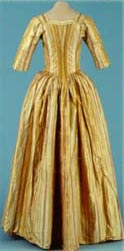
Back of Gown. Striped silk taffeta with checked pattern created by extra warp float, bodice and sleeves lined with linen, skirt edges finished with pinking. England or Virginia, 1770-1780. Associated with the Blair Family of Virginia.1983-225.
The clothing that people wore in the past has the ability to fascinate and involve us as few objects of their material culture do. Clothing is intimate. Viewing a garment in a museum collection elicits an almost instinctive urge to touch it and try it on ourselves (actions that are, of course, not recommended for reasons of conservation). For some, it is a wish to experience the beautiful fabrics, elaborate decoration, and tactile qualities ;experiences no longer found in most of our own clothing. For others, it is a desire to understand people from the past a little better; if we know such details as how they dressed themselves in the morning, what it felt like to be laced into stays, or what it was like to wear coarse linen and woolen while working in a Virginia tobacco field, we might better understand the routine, human aspects of their daily lives, which are so seldom revealed in the written records they left.
The clothing illustrated in this article was worn by living people who had much in common with us. Not only did people then respond to fashion, they also varied their garments based on the activity and the formality of the occasion. The eighteenth-century words "dress" and "undress" had meanings quite different from the way we use the words today, though the basic concepts are still viable. "Dress" clothing meant formal clothing with a different set of conventions and accessories from "undress," or informal clothing. In 1775, for example, a woman could still don a pair of exaggerated side hoops, or "panniers," to support her wide skirt for a dress occasion, while her undress clothing ;although it would appear quite formal to our eyes;had a more modest skirt size that may not have needed hoops at all. Similarly, the clothes in which a wealthy planter conducted his daily business differed significantly from what he wore to a ball at the Governor's Palace. The garments worn by a blacksmith or dairymaid for daily work were different from their best outfits, reserved for Sundays at church and infrequent special occasions.
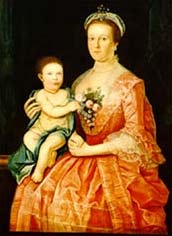
Mrs. Thomas Newton,Jr. (Martha Tucker) by John Durand.Oil on Canvas.
Virginia ca. 1770. Mrs. Newton of Norfolk, Virginia, wears a sack back gown with
self-fabric trimming, sheer neck handkerchief, sleeve ruffles, and a small
cap.Gift of M. Knoedler.,
G1954-273.
Textiles and clothing--ephemeral objects that are subject to moth, mildew, and the wear and tear of laundry, restyling, and recycling into quilts or rags; are nevertheless able to help us understand a great deal about history. Consider the fact that a planter's daughter in tidewater Virginia in the 1770s could have worn at the same time a gown of silk from China, underclothing of linen from Holland, and footwear made in England – all shipped in a vast network of trade from their places of origin to a shop or warehouse in London, where they were selected by a merchant, packed for a lengthy voyage across the ocean in a ship propelled by wind, to arrive finally in Virginia. Or that a slave – whose very freedom was entangled in a network of trade and commerce – could be wearing clothing made from inexpensive textiles imported especially for his use – a shirt of linen woven in northern Europe, woolen hose from Scotland, or a knitted cap from Monmouth, England. Clothing and accessories worn in eighteenth-century America were selected from sources all over the world.
Some upper-class Virginia men ordered suits custom-made to their measurements in London. They specified expensive fabrics like superfine woolen broadcloth or silks. Their suits were sometimes embellished with imported buttons and other expensive trimmings. Women could also purchase many of their items of apparel, especially petticoats, laces, shoes, stockings, cloaks, aprons, and even stays, ready-made through the import trade. Their gowns were more often made by local seamstresses or mantua makers. Some women made their own clothing, especially work garments and shifts. Only in frontier areas was most clothing homespun and homemade – and even there, traders and storekeepers quickly penetrated the backcountry to make imported goods available.
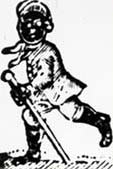
Woodcut.This detailed illustrated an advertisement for runaway slaves that appeared in the Virgnia Gazette (Purdie and Dixon) March 28, 1766.
The clothing worn by eighteenth-century Virginians was characterized by great diversity, as one would expect in a society ranging from royal governors and wealthy landowners to indentured servants and slaves. Upper-class Virginians kept abreast of the latest English fashions through imported garments, letters from England, news from travelers, and immigrating dressmakers or tailors. Surviving garments, portraits, and written records indicate that when affluent Virginians had occasion to dress up, they were very elegant indeed.
As early as 1724, Hugh Jones wrote in The Present State of Virginia that Williamsburg's leading families dressed like the gentry in London. Thirty-five years later, the reverend Jonathan Boucher described Virginians: "Solomon in all his Glory was not array'd like one of These. I assure you, Mrs. James, the common Planter's Daughters here go every Day in finer Cloaths than I have seen content you for a Summer's Sunday. You thought (homely Creatures as you are) my Sattin Wastecoat was a fine best, Lord help You, I'm noth'g amongst the Lace and Lac'd fellows that are here. Nay, so much does their Taste run after dress that they tell me I may see in Virginia more brilliant Assemblies than I ever c'd in the North of Engl'd, and except Royal Ones P'rhaps in any Part of it."

Mrs. Gavin Lawson (Susannah Rose) by John Hesselius. Oil on Canvas. Virginia, dated 1770. Mrs. Lawson wife of a planter and merchant of Stafford County, Virginia, wears a satin gown with stomacher front, fine lace, and pearls. 1954-262.
The concepts of comfort and modesty have always been relative and subject to the influence of fashion and the needs of the occasion. Like us, eighteenth-century people needed clothing for warmth and comfort, but they quickly abandoned those needs if fashion or the occasion dictated. During much of the eighteenth century, women's skirts were long and the sleeves covered the elbows; yet a woman would readily push up her sleeves and hike up her petticoats while doing laundry or working in the dairy, and, when fashion dictated it, women would shorten their skirts to the ankles, as many did in the 1780s.
When we look at ladies' corsets –"stays" –from the period, we cannot imagine how a woman could subject herself to such a garment. Yet the wearing of stays was as much linked to concepts of modesty and support as it was to figure shape; without her stays for most public occasions, a woman was considered not quite properly dressed at best and a "loose woman" at worst.
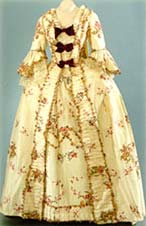
Sack Back Gown and Matching Petticoats. Brocaded silk taffeta, linen bodice and sleeve linings, made in England or Virginia by Elizabeth Dandridge Aylett Henley.G1975-340.
Someone who had worn stays from girlhood might scarcely have questioned their comfort or lack of it. (And who is to say that stays were any more uncomfortable than pointed-toe, high-heeled twentieth-century shoes?)
Climate also had a significant effect on clothing. In the sultry climate of Virginia many, even the upper classes, chose washable linen or cotton clothing for informal wear. A traveler in the early 1730s described the summer clothing of Virginians: "In Summertime even the gentry goe Many in White Holland [linen] Wast Coat and drawers and a thin Cap on their heads and Thread stockings [knitted linen]. The Ladyes Strait laced in thin Silk or Linnen. In Winter [they dress] mostly as in England and affect London Dress and wayes."
During the hot summer months, men often wore unlined coats and thin waistcoats of cotton or linen fabrics. Advising his brother about what to wear when he attended the College of William and Mary, Stephen Hawtrey wrote, "Your Cloathing in summer must be as thin and light as possible for the heat is beyond your conception . . .your Cloth suit unlined may do for the Month of May, but after that time you must wear the thinnest Stuffs that can be made without lining[;] some people . . . wear brown holland [linen] Coats with lining –some Crape –You must carry with you a Stock of Linnen Waistcoats made very large and loose, that they may'nt stick to your hide when you perspire."
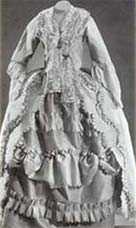
Gown and Matching Petticoat. Cream silk taffeta with crisp finish-lustring"-trimmed with pinked self-fabric,linen bodice and sleeve linings. By tradition made in England in 1778 and bought to Virginia by Mrs. Frances Norton. G1946-133.
Many Virginia women favored gowns made of lustring, a crisp, light silk that was often ordered for wear during the summer months. When the hot weather became unbearable, some women went without their stays for informal occasions and at home, although formal occasions still required them. One Virginia woman related in her diary that she did not bother to get dressed immediately on a particularly "sulterry" day; she remained "up stairs in only shift and petticoat till after Tea."
Clothing that reaches a museum collection has been culled by time, by curatorial selectivity, and by a process we might call "the survival of the finest." Most collections contain garments that are of the elegant, dress type, simply because everyday clothing has not survived. No one thought to save the plain, worn garments of a lower-class man or woman – if there was anything left to save but rags.
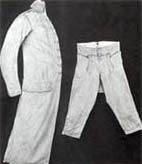
Unlined Coat and Breeches. Coat of coarse homespun cotton and wool, breeches of cotton, Isle of Wight County or Goochland County, Virgina, 1780-1790. the suit is sized to fit a youth ( the beeches have a 27-inch waist).1964-174.
To understand what most people wore in the past, museum collections need to be supplemented by carefully analyzed print sources and written records.
Some questions about people's appearance cannot be answered to our satisfaction, even after poring over all the surviving sources. We would very much like to know the size of the "average" person in the eighteenth century, but we can offer only partial answers. We do know that the unaltered bodices and stays in Williamsburg's collections have waistlines ranging from 21 1/2 inches to 34 inches, with an average of slightly over 25 inches. Two hundred and twenty-five men advertised as being runaways in the Virginia Gazette between the years 1750 to 1770 had an average height of 5 feet, 7 1/2 inches. Based on limited, non-scientific samples, these figures cannot be taken as averages for an entire period. Research continues in all aspects of appearance and clothing.
Article written by Linda Baumgarten, Curator of Textiles of the Colonial Williamsburg Foundation.
The article is an excerpt from Eighteenth-Century Clothing at Williamsburg, available from our online catalog.
